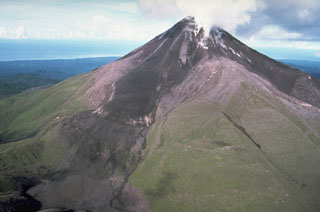Report on Bagana (Papua New Guinea) — 5 December-11 December 2007
Smithsonian Institution / US Geological Survey
Weekly Volcanic Activity Report, 5 December-11 December 2007
Managing Editor: Sally Sennert.
Please cite this report as:
Global Volcanism Program, 2007. Report on Bagana (Papua New Guinea) (Sennert, S, ed.). Weekly Volcanic Activity Report, 5 December-11 December 2007. Smithsonian Institution and US Geological Survey.
Bagana
Papua New Guinea
6.137°S, 155.196°E; summit elev. 1855 m
All times are local (unless otherwise noted)
RVO reported that during 18 October-10 December white vapor plumes from Bagana were occasionally accompanied by ash plumes generated by rockfalls from the edges of the lava flow on the SE flank. Occasionally, booming and roaring noises were heard and incandescence at the summit was observed. Two explosions were accompanied by ash plumes on 19 and 27 November. Incandescent lava fragments were ejected from the summit on 7 and 9 December. On 9 December, an ash plume rose to an altitude of 2.8 km (9,200 ft) a.s.l. A lava flow became active and was continuously incandescent down the SE flank.
Geological Summary. Bagana volcano, in a remote portion of central Bougainville Island, is frequently active. This massive symmetrical cone was largely constructed by an accumulation of viscous andesitic lava flows. The entire edifice could have been constructed in about 300 years at its present rate of lava production. Eruptive activity is characterized by non-explosive effusion of viscous lava that maintains a small lava dome in the summit crater, although occasional explosive activity produces pyroclastic flows. Lava flows with tongue-shaped lobes up to 50 m thick and prominent levees descend the flanks on all sides.
Source: Rabaul Volcano Observatory (RVO)

